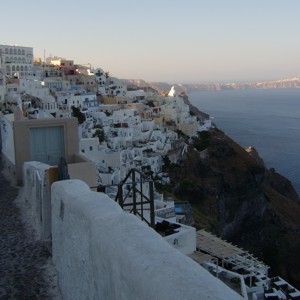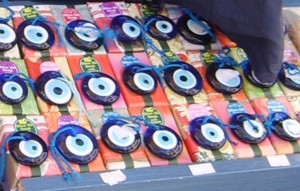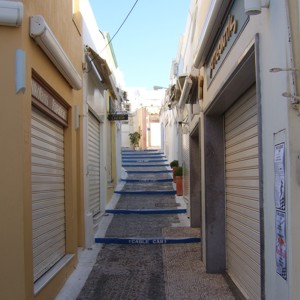The towns and villages on the island are some hundred metres or so above the sea and painted white; when you look at them from a distance, it makes the ridge appear snow-capped. This clinging-to-the-cliffs feature is very striking and photogenic:

I'm not going to give you yet another show of amusing holiday snaps, because I'm aware that looking at other people's vacation pics gets tired very soon, although I will point out that Santorini also suffers from the easy-to-make, hard-to-like blue eye design that is endemic to this part of the world:

No, what I'm going to blog about today is the way that places seem to take their attractiveness for granted. Santorini attracts hundreds of thousands of visitors every year. Today, for example, there were three cruise ships anchored in the lagoon. Tenders transported some 5,000 visitors to the dock at the bottom of the cliff, where they ascended either by cable car (4 euros each, with a queue stretching for as long as the journey is high, perhaps longer), by donkey (25-stone American woman on our launch: "They have a donkey ride! That's awesome!" — maybe not for the donkey) or by climbing up 654 steps. The ascent leads to Fira, population 1,850. Fira therefore pretty well depends on tourism for commercial survival.
You might have thought, as a consequence of this, that Fira would attempt to ensure that its main selling point — its picturesqueness — would not be undermined. However, it seems to make no effort at all in this direction. When you get into it, it's not actually all that pretty. Here's an example:

The above was taken about 8:30am, just after we got there. Yes, it was ridiculously early, but at that time there was no queue for the cable car. Yes, we had to wait ninety minutes for the shops to open, but as my elder daughter put it: "at least we got the choice of where to wait". As you can see, it's not great to look at; it's not much better when the store fronts are open and it's teeming with tourists, either. It's as if Santorini takes its prettiness as a given, and forgets that actually there has to be some substance behind it. It's like share prices: in part, when a share price is high it's simply because its price is high, but ultimately there has to be some dividend or book value to back it up. Santorini is trading on its dramatic setting and quaint streets, but it isn't paying the dividends.
Rhodes was a similar story, but not quite to the same extent. Yes, it had ugly overhead cables spoiling every rooftop view and (as I mentioned yesterday) scooters turning beckoning side-streets into dingy alleys, but it still had some cohesion about it. It was on the way down, though; the tourism was industrialised, but there are only so many times you can see shops selling exactly the same things as each other before they all blur into one. When those shops are the same ones that you saw in earlier stops, it makes it even worse.
It doesn't have to be this way, though. Mykonos does a great job of keeping itself pretty while still catering to hordes of tourist-bearing ships; occasionally a view will be spoiled by some ill-placed piece of modernity such as an air-conditioning unit or a thick, black, power cable, and they do have to park their scooters somewhere, but they maintain their standards. I'd go back to Mykonos like a shot if the opportunity arose, but Rhodes? I think it maybe has another half a day in it (that's Rhodes the town — the rest of the island looks to have a lot more to offer). Santorini, well, I'd come back here to check out some of the other towns on the island I guess, but not Fira.
It's not a modernisation thing, either. Capri, in Italy, is similar to Santorini in many ways, but it's much classier. It blends ancient and modern, image and actuality, style and substance, seamlessly. Santorini could be like that, but it doesn't even realise it has a problem.
Should the credit crunch bite, though, and fewer people take cruises round the Mediterranean, some destinations will be preferred over others. Mykonos will be one of those, but Santorini needs to get its act together if it wishes to join them.
Even if things don't take a downturn, though, Santorini's complacency could hurt it. Those hundreds of people I watched just now from the ship, having to walk down 654 steps to the beach and trampling in a day's worth of donkey dung as they did so, won't necessarily want to return in a hurry, either.